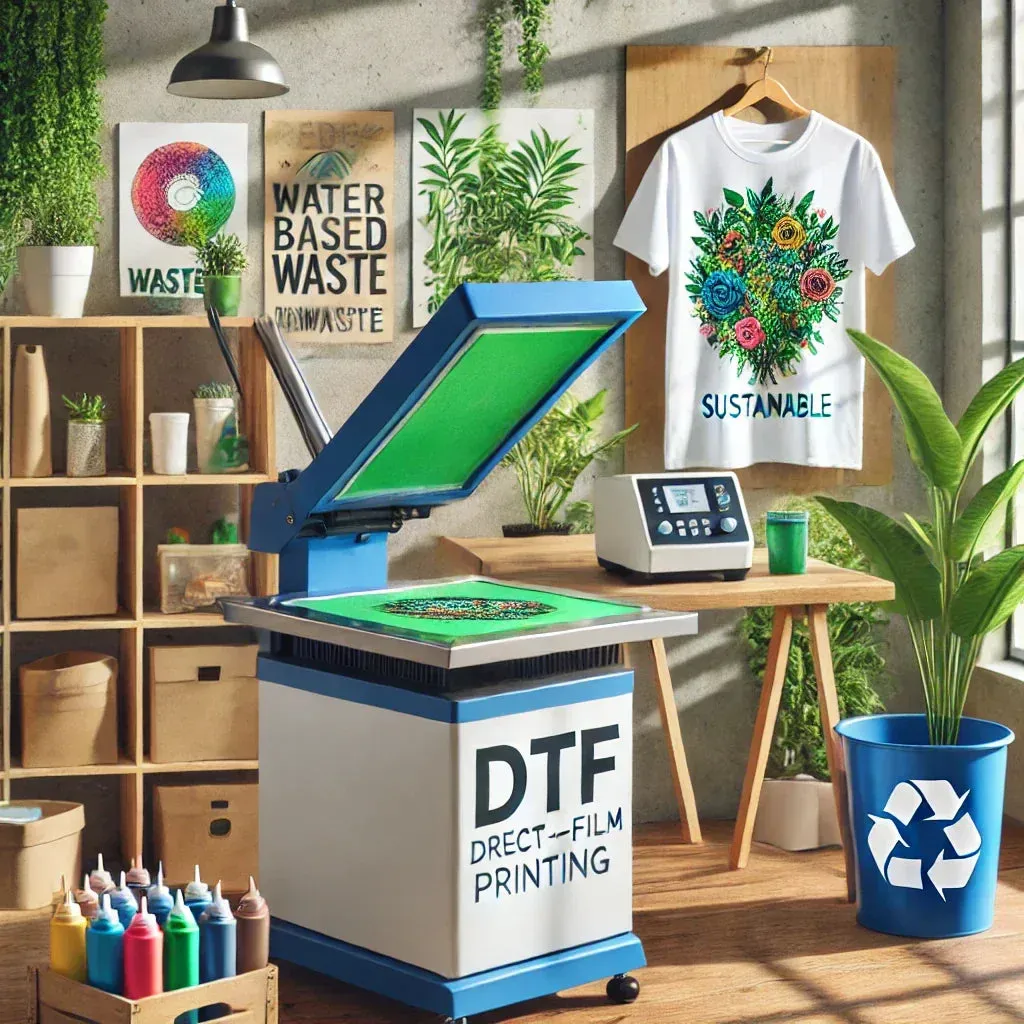The environmental impact of DTF printing is an increasingly pressing issue in the textile industry, reflecting the dual nature of technological advancement in manufacturing. Direct-to-Film (DTF) printing has gained traction for its versatility, enabling the transfer of intricate designs onto various fabrics, but it is not without its drawbacks. With the rapid adoption of this printing method, concerns surrounding DTF printing chemicals, energy consumption, and overall eco-friendliness have emerged. As manufacturers strive for sustainable DTF printing practices, it’s vital to scrutinize the environmental effects of textile printing, including the comparative sustainability aspects of traditional techniques. This article aims to shed light on the environmental implications of DTF printing and highlight innovative solutions that can make this technology more eco-friendly.
Examining the ecological footprint of Direct-to-Film (DTF) printing reveals essential insights into its sustainability within the textile sector. Often celebrated for its adaptability and efficiency, DTF printing presents several environmental challenges that merit attention. The utilization of various solvents and adhesives used in this technique raises significant questions regarding textile printing environmental effects and their long-term implications on ecosystems. Additionally, the energy consumption associated with the heat transfer process during DTF printing adds another layer of complexity to its sustainability profile. By exploring alternative sustainable practices and possible innovations, we can better understand the balance between modern printing technologies and environmental responsibility.
The Role of Chemicals in DTF Printing and Their Environmental Impact
DTF printing relies on various chemicals, particularly inks and adhesives that can contain harmful substances such as polyvinyl chloride (PVC) and solvents. These materials, if not managed correctly, pose significant risks to the environment. The disposal of these chemicals is a critical concern, as they can leach into the soil and waterways, potentially disrupting ecosystems and harming aquatic and terrestrial life. This underscores the necessity for manufacturers to be cognizant of their chemical usage and adopt protocols to mitigate these risks.
To promote eco-friendly practices, the DTF printing industry is currently seeking alternatives to traditional inks. Innovating with biodegradable inks presents a path to reducing the environmental impact associated with DTF printing. By transitioning to inks that safely decompose over time, manufacturers can significantly lower their chemical footprint. This shift not only helps alleviate ecological damage but also aligns with the rising consumer demand for sustainable products. Thus, an eco-centric approach toward chemical usage is essential for the advancement of the DTF printing process.
Energy Consumption in DTF Printing: A Sustainability Perspective
DTF printing’s energy consumption is a noteworthy factor in its sustainability profile. The process requires high temperatures during the heat transfer stage, leading to substantial energy use that can contribute to a larger carbon footprint. The reliance on electric equipment means that, depending on the energy sources, DTF printing can have greenhouse gas emission implications, particularly if powered by fossil fuels. Therefore, understanding and addressing the energy intensity of the DTF process is vital for manufacturers committed to reducing their environmental impact.
As energy efficiency becomes a focal point in sustainable manufacturing, there are opportunities within the DTF printing process to reduce energy consumption. Innovations in technology, such as optimizing heating processes and utilizing renewable energy sources, can significantly minimize the ecological footprint of DTF printing. Additionally, examining alternatives to traditional heat transfer methods can further enhance the sustainability of this printing technique. By prioritizing energy reduction strategies, the DTF printing industry can contribute to broader goals of carbon neutrality and sustainability.
Comparative Sustainability: DTF vs Traditional Printing Methods
When evaluating the sustainability of DTF printing, it is essential to compare it against traditional printing methods such as screen printing. DTF printing generally exhibits a lower water footprint, making it a more favorable option in regions where water scarcity is a concern. However, while it may reduce physical waste generated during the printing process, the presence of pollutants and harmful chemicals used in inks still challenges its overall environmental friendliness. This comparison accentuates the complexity of sustainability in textile printing.
Lifecycle assessments of printing methods reveal deeper insights into their long-term environmental impacts. While DTF printing may utilize fewer resources in certain aspects, its overall ecological footprint is affected by factors such as chemical usage and energy consumption. Therefore, manufacturers must weigh the benefits of innovative printing techniques against their environmental costs, driving the industry towards more sustainable practices by integrating more eco-friendly processes as a part of their operational workflows.
Innovative Practices for Eco-Friendly DTF Printing
In response to the growing environmental concerns linked to DTF printing, the industry is witnessing a surge in the development of innovative practices aimed at enhancing sustainability. The introduction of biodegradable inks represents a significant leap forward; these inks are engineered to break down more efficiently in natural environments, thus reducing the harmful effects associated with traditional chemical inks. By promoting the use of such eco-friendly alternatives, the textile printing industry can align with global sustainability standards and consumer expectations.
Moreover, the push for recyclable films highlights another avenue for reducing the environmental impact of DTF printing. Efforts to create films that can be repurposed or safely disposed of are essential in mitigating waste associated with the printing process. Utilizing recyclable materials can significantly curtail not only disposal costs but also the environmental burden commonly attached to hazardous materials. Embracing these innovative solutions can help position the DTF printing industry as a leader in sustainable practices within the textile sector.
Regulatory Pressures and Industry Awareness in DTF Printing
As awareness of environmental impacts grows, regulatory pressure surrounding chemical use and energy consumption in DTF printing is increasing. Governments and industry bodies are beginning to implement stricter regulations regarding the use of harmful chemicals, prompting manufacturers to reconsider their materials and practices. This regulatory landscape encourages the manufacturing sector to adopt a more responsible approach to DTF printing, fostering the development of safer, more sustainable alternatives.
In an era where sustainability is paramount, the textile industry is gradually shifting towards practices that prioritize both production efficiency and environmental responsibility. Companies are recognizing that embracing eco-friendly materials not only helps in compliance with regulations but also caters to a market that increasingly values sustainability. By proactively adapting to these changes, the DTF printing industry can foster a culture of responsibility and innovation that positions them favorably in the marketplace while mitigating negative environmental effects.
Future Directions for Sustainable DTF Printing
The future of DTF printing hinges on ongoing research and innovation aimed at minimizing its environmental footprint. As consumer demand for sustainable products rises, the industry is poised for a transformative phase that emphasizes the development and adoption of eco-friendly technologies. This includes advancements in ink formulations, manufacturing processes, and the materials used in DTF printing, all tailored to reduce waste and enhance recyclability. By proactively investigating and implementing sustainable practices, the DTF printing sector can begin to realign itself with emerging eco-conscious market trends.
Furthermore, collaboration among manufacturers, researchers, and regulatory bodies will play a crucial role in defining best practices for sustainable DTF printing. Engaging in partnerships that prioritize environmental stewardship will not only mitigate the negative impacts of printing processes but also inspire innovation across the textile industry. As DTF printing continues to evolve, the emphasis on sustainability will likely lead to the creation of a more responsible and eco-friendly production environment that resonates with today’s environmentally aware consumers.
Frequently Asked Questions
What is the environmental impact of DTF printing compared to traditional methods?
DTF printing presents a mixed environmental impact. While it may have a lower water use than traditional screen printing, concerns arise from its high energy consumption and use of harmful chemicals. Traditional methods often involve significant physical waste, while DTF printing risk lies in its chemical disposal and energy sources, which can contribute to greenhouse gas emissions.
How do DTF printing chemicals affect the environment?
Chemicals used in DTF printing, such as adhesives and inks that often contain PVC and solvents, pose significant environmental risks. Improperly disposed chemicals can contaminate soil and water systems, leading to lasting ecological damage. Manufacturers are urged to adopt safer alternatives to minimize these impacts.
Is sustainable DTF printing a viable option for the textile industry?
Yes, sustainable DTF printing is becoming increasingly viable due to innovations such as biodegradable inks and recyclable films. These advancements help reduce the overall ecological footprint, making DTF printing a more environmentally friendly choice in contrast to traditional methods.
What initiatives are being taken to make DTF printing more eco-friendly?
Innovative solutions such as the development of biodegradable inks and recyclable films are being implemented to enhance the eco-friendliness of DTF printing. These initiatives aim to reduce chemical waste and energy consumption, contributing to a more sustainable textile printing industry.
What is the energy consumption associated with DTF printing?
DTF printing is characterized by significant energy consumption, particularly during the heat transfer phase. The use of electric presses and heated equipment increases the carbon footprint of the printing process, especially when powered by non-renewable energy sources.
Are there regulations affecting the environmental impact of DTF printing?
Yes, increasing regulations are being introduced to limit harmful chemicals in DTF printing. These regulations encourage manufacturers to transition towards eco-friendly practices, promoting sustainable DTF printing methods and gradually reducing the industry’s environmental footprint.
| Key Point | Details |
|---|---|
| Introduction | DTF printing is popular in textiles but raises environmental concerns. |
| Environmental Concerns | Key issues include chemical use and energy consumption. |
| Use of Chemicals | Harmful chemicals like PVC used in inks can cause environmental toxicity. |
| Energy Consumption | DTF printing’s heat transfer process is energy-intensive, contributing to greenhouse emissions. |
| Comparative Sustainability | While DTF may have a lower water footprint, harmful chemicals remain a major concern. |
| Innovative Solutions | Exploration of biodegradable inks and recyclable films to reduce ecological impact. |
| Industry Regulations | Stricter regulations on harmful chemicals promote safer alternatives. |
Summary
The environmental impact of DTF printing is a critical issue as this innovative method of textile decoration gains popularity. By exploring the concerns surrounding chemical usage and energy consumption, we uncover the complexities of sustainability in the printing industry. With ongoing advancements in biodegradable materials and stricter regulations, manufacturers are encouraged to adopt more eco-friendly practices. As stakeholders in the industry become increasingly aware, the push towards responsible and sustainable production methods is vital. The balance between efficiency and environmental safeguarding is paramount, paving the way for a greener future in DTF printing.



